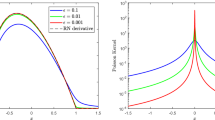Summary
The numerical accuracy of computing the kinetic energy of a quantum-mechanical system using the gradient operator is studied in this paper. To this end, a matrix formulation for deriving multi-point central-difference formulas for the first and higher-order derivatives of a non-singular function is developed. In particular, 7-point and 9-point formulas for derivatives of order one through six and one through eight, respectively, have been derived explicitly. Accuracy of the formulas has been tested by comparing the calculated values of the derivatives of a function with the exact ones. The 9-point formula for the gradient has been used to compute the kinetic energy of a particle and the results have been compared with those of the 9-point Laplacian. The calculations indicate that the kinetic energy computed via the gradient operator is as accurate as that obtained via the Laplacian operator.
Similar content being viewed by others
References
F. B. Hildebrand:Introduction to Numerical Analysis (McGraw-Hill, New York, N.Y., 1956).
J. C. Strikwerda:Finite Difference Schemes and Partial Differential Equations (Wadsworth and Brooks, Belmont, Cal., 1989).
W. G. Bickley:Math. Gaz.,25, 19 (1941).
A. Abramowitz andI. A. Stegun (Editors):Handbook of Mathematical Functions (National Bureau of Standards, Washington, D.C., 1972).
D. Vautherin andD. M. Brink:Phys. Rev. C,5, 626 (1972).
Q. Haider andD. Gogny:J. Phys. G,18, 993 (1992).
T. H. R. Skyrme:Nucl. Phys.,9, 615 (1959).
W. H. Press, B. P. Flannery, S. A. Teukolsky andW. T. Vetterling:Numerical Recipes: The Art of Scientific Computing (Cambridge University Press, New York, N.Y., 1988).
Q. Haider, D. Gogny andM. S. Weiss: University of California Report No. UCID-2170 (1989).
Q. Haider andL. C. Liu:J. Phys. G,14, 1527 (1988).
Q. Haider andL. C. Liu:Z. Phys. A,335, 437 (1990).
E. Merzbacher:Quantum Mechanics (John Wiley, New York, N.Y., 1970).
P. Ring andP. Schuck:The Nuclear Many-Body Problem (Springer-Verlag, New York, N.Y., 1980).
P. Bonche, H. Flocard, P. H. Heenen, S. J. Krieger andM. S. Weiss:Nucl. Phys. A,443, 39 (1985).
A. DeShalit andH. Feshbach:Theoretical Nuclear Physics Vol. 1:Nuclear Structure (John Wiley, New York, N.Y., 1974).
Author information
Authors and Affiliations
Rights and permissions
About this article
Cite this article
Haider, Q. Numerical evaluation of the kinetic-energy operator. Nuov Cim B 109, 1039–1048 (1994). https://doi.org/10.1007/BF02723228
Received:
Accepted:
Published:
Issue Date:
DOI: https://doi.org/10.1007/BF02723228




